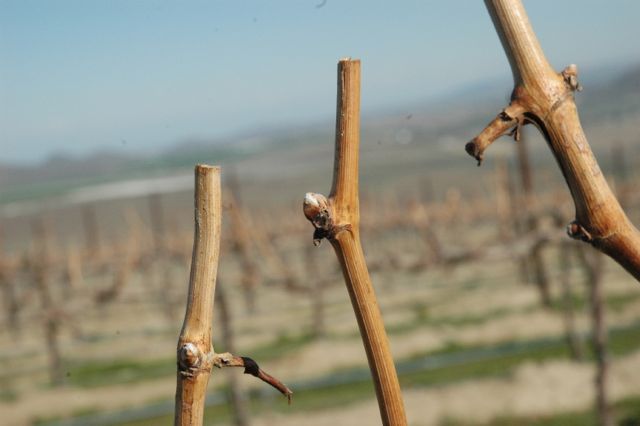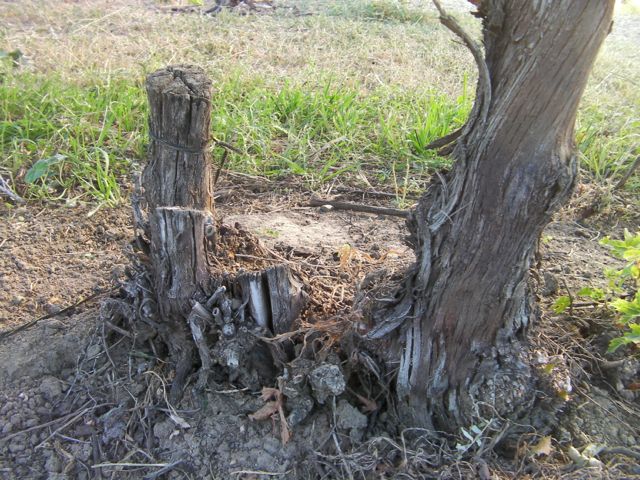
Washington wine country temperatures for the past 10 days or so have varied from 25 to 35 degrees, a good level to keep grapevines in their winter slumber without causing damage.
With that in mind, here is a quick primer on how damage can happen to Washington wine grapevines.
Buds
Bud damage is the most common problem with wine grapevines in Washington wine country. Buds are the small bumps that form each June and become the following year’s growth. In other words, the 2013 vintage began to take shape in June 2012. Inside each bud are really small leaves, and from them spring forth leaves, canes, shoots and grapes.
Within each bud is a set of three smaller buds, known as the primary, secondary and tertiary buds. The primary bud accounts for most of the grapes grown on a vine each year. If the primary bud becomes damaged by cold or extreme weather, the secondary bud will then take over. The secondary bud can be counted on to produce about half the crop of the primary bud. The tertiary bud will jump in if the primary and secondary buds are damaged. However, though the tertiary bud is least susceptible to damage, it also tends to produce no grapes. If the damage is so bad that only the tertiary bud is left intact, it still can be trained and used to create buds for the next year’s vines.
Determining bud damage is as simple as taking a razor blade and cutting a bud in half. If a grape grower sees green inside the bud, it is unlikely there is much if any bud damage – however that particular bud will no longer be fruitful. If the grape grower sees black inside the bud, then things are pretty grim for that vine and, likely, the surrounding vineyard.
Typically, growers will go through a number of vines in a block to check for damage after a winter event.
Phloem
Phloem damage refers to bark around a vine’s canes and trunks. Washington State University researchers say if temperatures drop to a certain point and 10 percent phloem damage happens, then the vine’s wood can become damaged. According to WSU, the phloem can handle up to 50 percent damage and still produce grapes.
Xylem
Xylem is the wood on a vine, and damage to it can critically compromise a grapevine’s well-being and even its survival.
How cold is too cold for grapevines?
How cold must it get for a grapevine to be damaged in Washington wine country? Several factors go into making that determination. Three important factors include:
- Variety
- Elevation
- Cold hardiness
Some European grape varieties, in particular Riesling, Cabernet Franc and Gewurztraminer, are deemed “winter hardy.” Others, including Zinfandel, Syrah and Merlot, are considered “tender” to winter damage. At WSU’s research station in the Yakima Valley town of Prosser, cold hardiness is measured by variety.
Cold hardiness in Washington wine country
For example, on Jan. 15, 2013, Cabernet Sauvignon would incur 10 percent bud damage if temperatures reached minus 8 Fahrenheit. Bud damage would soar to 50 percent at minus 10 and 90 percent at minus 12.5. Phloem damage would occur at 4.5 degrees, while xylem damage would begin at minus 11.5 degrees.
Riesling, meanwhile, would see 10 percent bud damage at minus 14, 50 percent bud damage at minus 17 and 90 percent bud damage at minus 18.5 degrees.
Concord grapes, which are an important crop in Washington, are extremely winter hardy. It won’t begin to suffer bud damage until temperatures plummet to minus 16, and 90 percent bud damage won’t occur until minus 24.5 degrees (at which time, the region would have all kinds of problems).
Syrah, which is considered a tender variety, will begin to see bud damage at minus 7, and high bud damage at minus 12.5 degrees.
So if you want to grow Syrah in Washington wine country, you should consider growing it in an area that historically never gets too cold. For the past 60 years or so, that would have been in the Horse Heaven Hills, though that region saw significant damage a couple of years ago for the first time in decades.
Location matters in Washington wine country
Grape growers can limit damage to their vines by planting vineyards:
- At higher elevations because cold air sinks and can “slide” downhill.
- In windy areas because cold air will be less likely to hang around if the wind is blowing.
- Near large bodies of water such as Lake Chelan or the Columbia River because water can moderate surrounding temperatures.
These three factors are reasons why Zinfandel, for example, is most often grown in the Lower Columbia Gorge of Washington wine country. There is near-constant wind and the land slopes toward the Columbia River.
Sometimes, simply having cold weather isn’t the biggest issue. For example, in 1996 temperatures skyrocketed into unseasonably mid-50s in mid-January. As a result, grapevines began to awaken from their winter slumber and water began to fill the plants’ cells. Then temperatures crashed to minus 18 in areas. The water inside the cells frozen and expanded. This caused damage to about 60 percent of the vines in the Columbia Valley. Even worse, cloudless skies during the day reflected off the snow around the vines, warming them during the day. Nighttime temperatures would plummet again, causing additional damage.
In many cases that year, grape growers simply headed into their vineyards with chainsaws, cut down their vines and retrained them from their root systems, which were safely underground.
Importance of own-rooted vines in Washington wine country

This extreme action can take place only in Washington. In any other region of the world, vines would need to be pulled out of the ground and replanted. Then the next three years’ worth of crop would be lost. However, Washington wine country is one of the few places on the globe where grapevines are planted on their own roots.
Phylloxera, a root louse, destroys European grape varieties. In the 1800s, most of France’s vines were wiped out by phylloxera. The same thing happened in the last century in California, Oregon and regions on the East Coast of the United States. To battle the root louse, European grape varieties are grafted onto phylloxera-resistant vines native to North America. Thus, the part that is several inches above ground (and away from the phylloxera) is the European variety.
Just a tiny bit of phylloxera exists in Washington wine country, and it doesn’t affect wine grapes. The well-draining sandy soils thwart phylloxera because it needs dense soils to move around better. Phylloxera also does not like Washington’s cold winters.
While growing wine grapes in Washington’s Columbia Valley is not difficult, cold winter events every five to eight years can cause all kinds of challenges unlike those found elsewhere in the world of wine.

Leave a Reply